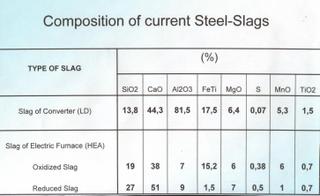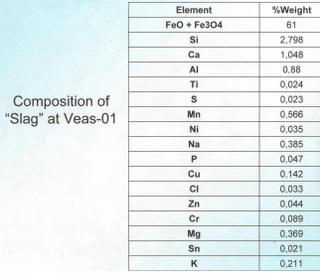For comparing the Slag coming from a current Blast Furnace with those belonging to Veas-01, the following slide exhibits three types of slag: (a) Slag of Converter (LD), (b) Oxidized Slag of Electric Furnace, and (c ) Reduced Slag of HEA, too. Please, note the high content of CaO in each one.
) Reduced Slag of HEA, too. Please, note the high content of CaO in each one.
 ) Reduced Slag of HEA, too. Please, note the high content of CaO in each one.
) Reduced Slag of HEA, too. Please, note the high content of CaO in each one.
Compared with the abovementioned image, here is added a couple of slides, analysis carried out at both IDIEM and USACH in Chile, concerning to the main composition of the supposed slag forming some kind of veins around the melt crust of the big Rock named Veas-01. The first one shows the %wt contents by elements, taking into account the high presence of Fe oxides, of almost 61% in weight; the Ni contents of 350 ppm is high enough for iron slag coming from any blast furnace. The second one displays the bulk of the compounds found within the so-called slag; compounds consisting of Gamma Iron Silicate (Fe2SiO4), Monticellite (CaMgSiO4), Quartz and Goethite (FeO(OH)).


Dr. Bern Lehmann’s report found Chromite, and low Ni
During november, 2004, Carlos Hidalgo & Asociados Office contacted Dr. Bern Lehmann at the T-University of Clausthal, Germany. After the remittance of the money and Invoice Proform, the chemical analysis was made using Electron Microprobe of such institution. Here it is reproduced some of results.
On wed, 17 nov 2004, in the beginning, and because of the uncommon length of the plate in Veas-01 steel, Dr. Lehmann mistook the Fe-C Widmanstatten ferrite for those formed by Fe-Ni saying: “We just checked the largest piece RX-01 under reflected light, after 10 sec etching with a drop of HCl conc. There is a very distinct Widmanstaetten fabric which clearly identifies the sample as iron meteorite. Congratulations! See pictures attached. The overview picture is in air, the detailed picture is in oil. We will now prepare standard-size polished sections and study some of the interestingly looking mineral inclusions by microprobe.”
On wed, 15 december 2004 Dr. Lehmann writes: “The four samples which we prepared as polished sections so far do not show any bacterial textures, but they have a very interesting polymineralic inclusion assemblage. See some examples attached (µ refers to length of photograph). You had similar photographs but of lower quality of polish. You can even see the faint Widmannstaetten texture in one photograph (RX-01-air-2700µ-A.jpg) which comes out by exposition to air for some weeks (so-called "air etching"). I contacted a specialist, but he can do lead and osmium isotopes end of next year only!.”
Nevertheless, after detailed electro microprobe analysis he do not found Ni enough to form the Widmanstaetten fabric between Fe and Ni. Thus, on Monday, 03 january 2005 Dr. Bern Lehmann writes: “We now did electron microprobe analysis on some polished sections. Regretfully, it turned out that the nickel content was in between 560 and 1600 ppm only. This rules out any extraterrestrial origin of this sample, in spite of the Widmanstaetten fabric”. And added: “Quite a deception: I had hoped that your earlier report on low nickel was an analytical mistake (in Chile), but it’s not. The iron matrix has 550-1530 ppm Ni only. To my knowledge, all iron meteorites have a few percent Ni. The inclusions are (Fe,Mn)S, chromite and complex P-Fe-Mn-O phases which are known both from Steel and iron meteorites.
On april, and after several tests he writes the following, in his final report to Chile:
1. There is two very slightly different domains in the samples in terms of nickel content. One domain has 638 ±66 ppm Ni (n=10), the other 1455 ±60 ppm Ni (n=10). The iron content in both domains is 100.0 to 102.1. This abundance is a bit too high due to calibration problems. There must be a minor content of carbon which we did not analyze. The "high-Ni" population has 301 ±297 ppm Mn and 815 ±126 ppm Cr (n=10), whereas the "low-Ni" population has Mn content below our analytical detection limit of around 40 ppm Mn, and Cr content at around 100 ppm or less. The low nickel content argues against a meteoritic origin. Thats where we stopped further investigation.
2. We also shortly looked at the various bleb-like mineral inclusions. These consist of FeS, Chromites and (Fe,Mn)S phases, plus others no-identified. There are also some inclusion rims rich in phosporus. Such inclusions are known both from industrial iron/steel and from meteorites. I attach you our reconnaissance analytical data.
In summary, based on nickel content and structure, the iron rock is a low-C steel... In spite of these results, I wish you good luck in the search for a less trivial nature of this intriguing rock and will be curious to learn your arguments for a non-smelter origin of the samples.
Bernd Lehmann
Institute of Mineralogy and Mineral Resources
Technical University of Clausthal
The Mineral Chromite in Siderites
Finally, to conclude the present report, we reproduce a discussion regarding to Chromite exposed on may 2004 by Dr. Karl Thomas Fehr, under the title “Unusual large Chromite crystals in the Saint Aubin iron meteorite”. Professor Fehr works by the Department of Earth and Eviromental Sciences, Section Mineralogy, Petrology, and Geochemistry, from the Ludwig-Maximilians University, Munchen, Germany:
“Chromite is a common minor mineral in iron meteorites and chondrites. Chromites of iron meteorites usually occur in close association with silicates and troilite (FeS), and sometimes occur as an isolated phase within the metal. In chondrites, they are usually found together with the metal phase. Chromites with grain sizes of 10-100 microns rarely exceded the dimension of 0.8 mm as in the Landes octahedrite (Bunch et al. 1972). The grains are usually rounded, and euhedral octahedral crystals scarcely show tetrahedral or rhombic shapes in cross-sections. In the Saint Aubin iron meteorite, chromite does not form single crystals but contact twins along (111) according to the spinel law. Consequently, chromite displays either pseudotrigonal- or pseudohexagonal shaped cross-section. In magmatic iron meteorites, metal and chromite co-precipitate due to the low solubility of Cr in iron metal (Ulf-Moller 1998). Crystal growth of chromite proceeds from a supercooled metal liquid at supersaturated conditions. The formation of large crystals requires slow growth rates and a low degree of supersaturation close to the liquidus. Under these conditions, neither heat dissipation nor diffusion should play a significant role. Therefore, the large crystal size of 3 cm of the chromite in the Saint Aubin meteorite indicates the presence of stable supersaturated conditions during growth, which implies a constant temperature regime forma long period in the meteorite parent body of Saint Aubin. Within the system Fe-Cr-S-O, chromite crystallizes from liquids with very low amounts of Cr and O close to the Fe-FeS join (Ulf Moller 1998). This is confirmed by the composition of Saint Aubin chromite, which is close to the composition of pure endmember chromite. Similar pure chromite was also reported from the Sychevka octahedrite (Krot et al. 1992), where it is enclosed in the metal phase similar to the Saint Aubin meteorite. The Sychevka chromite contains only minor amounts of vanadium (0.09 wt% V2O3) but displays appreciable amount of zinc (0.77 wt% ZnO) in contrast with the Saint Aubin chromite. Vanadium is not routinely analyzed by microprobe analysis of meteorites but comparable vanadium contents between 0.76 and 0.97 wt% were observed in chromites fo the Landes octahedrite (Bunch et al. 1972), the chondrites of Suizhou (Chen et al. 2003), and Little Minnie Creek (Bevan et al. 2001). These chromites do not displays endmember composition but contain remarkable amounts of MgO, MnO, ZnO, Al2O3, and TiO2, as reported for the chromite of the Bocaiuva and Miles octahedrites. The occurrence of chromite in the presence of a silicious melt phase as indicated by the close association fo chromite and various silicates in silicate inclusions within these meteorites.

